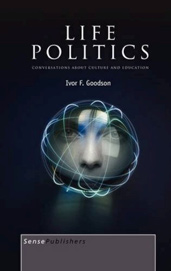Life Politics: conversations about education and culture
Mediation is the Message
QUESTION: But the questions are if our beliefs are the same or they have been changed, and if we shall support in a political way our own beliefs and how.
IVOR: Whether our beliefs are the same? I suppose when I say our beliefs are the same, I mean our big beliefs. For example, that you treat everybody equally or that everybody has equal power. Our big beliefs remain the same, but our strategic responses have changed. As I said to you, the belief in progressive pedagogy was the correct belief in the early sixties, because inclusive possibilities were there. So our belief was equal to our position. Now our positions have changed. We have to adapt the belief in some way. Actually the big belief is the same, the aspiration is the same, to treat everybody equally, but because of the substantial repositioning, there are two different ways to respond. I’m mentioning here (Briend)’s distinction between pre-figurative politics and strategic politics. The strategic politics is: you take a new situation and you work out a way in which your beliefs are reactivated in the new situation. You find a new way to speak about what you believe in. And that may mean changing your strategic position on, say, progressive pedagogy. We are not talking about changing our beliefs. I don’t think we can talk about changing our beliefs. We are saying: at this moment that doesn’t work anymore. But that’s a strategic point, not an ideological point, and that’s a very important distinction. Strategically we are saying, “It’s no good any more”. That wouldn’t deliver the belief by now. So he said: there are two ways that you do politics in a situation where you don’t like your positionality. One is you invent a new strategic politics, you involve yourself in some way in contesting the things that are creating a bad position. And he says the other possibility is what he calls pre-figurative politics, where you find, once again, a room or space where all of those things that you believe in can be done. So you bring together all the different children in one room, all the different students in one room. And just in that room you do what you believe, for example, that you should deal equally with everything. Let’s see a simple situation: you have a lecture, and there are all sorts of people in a lecture, people from different races and different classes come to the lecture. And at the front the professor is sitting, the professors ask most of the questions, but you deliberately disrupt the (...) of the room by asking to the class, by asking somebody in back what they think. You bring in, you include all the people in the room. In some symbolic way, the janitor comes and you thank him for your coffee, you speak to him in front of everybody. You’re doing pre-figurative politics in that moment by saying “what I believe in is to include everybody in the room, and I’ll make sure that if somebody is making a special claim for privilege, I’ll disrupt now: “thank you professor for your prestigious question, what do you think at the back?” That is, just in a moment, trying to do pre-figurative politics. You can be more substantial than that, you can try and create that room permanently, but that’s pre-figurative politics, where you’re showing people “this, in this moment is what I believe about the world”. So that’s different in a way from strategic politics, that’s saying this is my honest belief, this is how I deal with people, I believe in all to be equal, and in second stage it means that you act equally with them. So it’s a daily politics.
